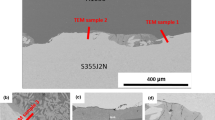Diffusion interaction at an interlayer boundary of St3 steel–AD1 aluminum after explosive welding and aluminizing by melt immersion is investigated. Test heat treatment regimes are revealed providing formation of coatings based on iron aluminides on a steel surface. It is shown that in order to form Fe2Al5 intermetallic on a steel surface with the hardness of 10 GPa, an explosion welded steel-aluminum composite must be given double heat treatment. After the first (660 °С, 3 h) a two-layer (Fe2Al5 and FeAl3) diffusion zone is formed, and after the second (640 °С, 3 h) it is destroyed along a main crack between the Fe2Al5 and FeAl3 interlayers. In order to form an Fe2Al5 intermetallic coating on a steel surface an aluminized layer obtained by melt immersion must be heat treated at 800 °C. Doping the diffusion zone with Si leads to the appearance of additional phases Al7Fe2Si and (Al, Si)5Fe3 within the composition, and an increase heat treatment duration leads to a reduction in coating hardness to 7.5–8 GPa.










Similar content being viewed by others
References
B. Abdolahi, H. R. Shahverdi, M. J. Torkamany, et al., “Improvement of the corrosion behavior of low carbon steel by laser surface alloying,” Applied Surface Sci., 257, No. 23, 9921–9924 (2011).
C. J. Wang and M. Badaruddin, “The dependence of high temperature resistance of aluminized steel exposed to water-vapour oxidation,” Surface and Coatings Technology, 205, No. 5, 1200–1205 (2010).
W. Sun, Q. Z. Cai, Q. Luo, et al., “Effects of diffusion annealing on microstructure and anti-oxidation property of hot-dipped aluminum coating on 45 steel,” Trans. Materials and Heat Treatment, No. 1, 024 (2011).
Y. I. Oka, K. Ishikawa, and H. Tezuka, “Water droplet erosion resistance of aluminizing diffusion coatings on steel tubes,” Materials Transactions, 59, 237–243 (2018).
K. Żaba, “Wear resistance of aluminized steel plates,” Archives of Metallurgy and Materials,56, No. 4, 871–882 (2011).
S. P. Sah, E. Tada, and A. Nishikata, “Enhancing corrosion resistance of type 310S stainless steel in carbonate melt by hot-dip aluminizing,” J. Electrochemical Society, 165, No. 7, 403–411 (2018).
F. Rouillard, J. L. Courouau, B. Duprey, et al., “Evaluation of the compatibility of aluminide coatings in high-temperature sodium for fast reactor application,” Oxidation of Metals, 88, No. 1–2, 221–233 (2017).
J. R. F. Ramirez, K. Gopalan, and L. Otremba, US Patent Application No. 15/099,732 (2017).
Z. Zhou, F. Xie, and J. Hu, “A novel powder aluminizing technology assisted by direct current field at low temperatures,” Surface and Coatings Technology, 203, No. 1–2, 23–27 (2008).
K. Murakami, N. Nishida, K. Osamura, et al., “Aluminization of high purity iron by powder liquid coating,” Acta Materialia, 52, No. 5, 1271–1281 (2004).
A. B. Smith, A. Kempster, and J. Smith, “Vapour aluminide coating of internal cooling channels, in turbine blades and vanes,” Surface and Coatings Technology, 120, 112–117 (1999).
H. O. Pierson, Handbook of Chemical Vapor Deposition: Principles, Technology and Applications, William Andrew, New York (1999).
Y. Zhang, B. A. Pint, K. M. Cooley, et al., “Formation of aluminide coatings on Fe-based alloys by chemical vapor deposition,” Surface and Coatings Technology, 202, No. 16, 3839–3849 (2008).
Y. P. Zaikov, V. A. Kovrov, I. Brodova, et al., “Electrolytic aluminizing of low-carbon steel in NaF–KF–AlF3 melt,” Advanced Materials Research, 1088, 250 (2015).
V. A. Kovrov, V. Tsvetov, Y. Zaikov, et al., “Electrolytic aluminizing of low carbon steel as protection treatment for current leads against high temperature oxidation,” Materials Science Forum, 844, 141–145 (2016).
I. G. Brodova, I. G. Shirinkina, Y. P. Zaikov, et al., “Structure and phase composition of protective coatings on steel produced by methods of liquid-phase calorizing,” The Physics of Metals and Metallography, 116, No. 9, 879–887 (2015).
Yu. F. Ivanov, Yu. A. Kolubaeva, S. Yu. Filimonov, et al., “Steel structure formation and properties with complex electron-explosion an electron-beam treatment,” Izv. Vyssh. Uchebn. Zaved., Chern. Met., No. 12, 43–48 (2008).
W. J. Cheng and C. J. Wang, “Observation of high-temperature phase transformation in the Si-modified aluminide coating on mild steel using EBSD,” Materials Characterization, 61, No. 4, 467–473 (2010).
V. G. Shmorgun, O. V. Slautin, D. V. Pronichev, et al., IOP Conf. Series: Earth and Environmental Science (EES), Vol. 87 (2017). [Electronic source] URL: http://iopscience.iop.org/article/10.1088/1755–1315/87/9/092025/pdf
D. V. Pronichev, L. M. Gurevich, M. D. Trunov, et al., “Investigation on the corrosion resistance of Al-steel laminated composite,” Contemporary Eng. Sci., 8, No. 23, 1083–1090 (2015).
V. V. Litvinov, V. I. Kuz’min, V. I. Lysak, et al., “Features of explosive welding of thick-sheet steel-aluminum composites,” Izv. Volgograd. Gos. Tekhn. Univ., No. 5, 44–49 (2010).
S. Kobayashi and T. Yakou, “Control of intermetallic compound layers at interface between steel and aluminum by diffusion treatment,” Mater. Sci. and Eng. A., 338, No. 1–2, 44–53 (2002).
J. L. Murray, “Fe–Al binary phase diagram,” in: Alloy Phase Diagrams, H. Baker (Ed.), ASM Int., Materials Park, OH, USA (1992).
Work was carried out with financial support of a grant from the President of the Russian Federation for state support of young Russian scientists MK-1196.2019.8.
Author information
Authors and Affiliations
Corresponding author
Additional information
Translated from Metallurg, Vol. 63, No. 7, pp. 84–89, July, 2019.
Rights and permissions
About this article
Cite this article
Shmorgun, V.G., Slautin, O.V. & Kulevich, V.P. Features of Diffusion Interaction in Steel-Aluminum Composite After Explosive Welding and Aluminizing by Melt Immersion. Metallurgist 63, 766–774 (2019). https://doi.org/10.1007/s11015-019-00887-8
Received:
Published:
Issue Date:
DOI: https://doi.org/10.1007/s11015-019-00887-8




